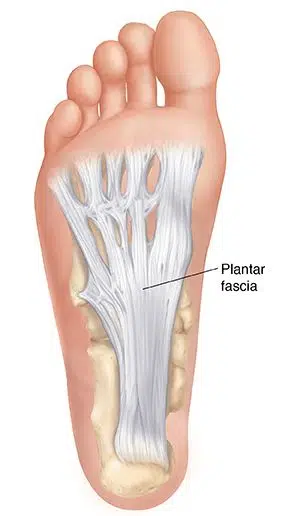What causes heel pain?
Heel pain can be caused by injury, such as a twist or fall, repetitive stress or load and pounding of the heel. Heel pain could also be caused due to the foot type such as high or low arch foot type. However, the common cause of heel pain is Plantar fasciitis, or inflammation of the plantar fascia.
What is Plantar Fasciitis or heel pain?
Heel pain is a very common foot problem. Pain usually appears under the heel, behind the heel or the entire heel. Patients can sometimes feel the pain in the arch of their foot. It usually affects just one foot, but it can affect both feet. The pain may be described as dull pain, some people may experience a sharp pain also. While some patients may feel a burning or ache on the plantar (bottom) aspect of their foot. The pain is typically worse in the morning when you take the first steps out of bed, or after a period of reset. Sometime it can be difficult to climb the stairs due to stiffness of the heel. Furthermore, some people may also feel pain after prolonged activity, this is due to the increased inflammation.

What is Plantar Fascia?
The plantar fascia is a strong web-like ligament that originates from the calcaneum (heel bone) and inserts to the tip of the foot.
Who’s at risk of Plantar Fasciitis?
- overweight or obese -the increased pressure on your plantar fascia ligaments. Especially, after a sudden weight gain.
- Women who are pregnant
- Distance runner
- Repetitive load or stress on the plantar fascia
Signs and symptoms of heel pain or plantar fasciitis:
- Deep, dull, poorly localised pain beneath the heel. Can be sharp and stabbing.
- Pain upon weight-bearing after periods of rest (i.e. ‘first step pain’)
- Pain eases with initial activity
- Pain increases with prolonged weight-bearing activities
How is plantar fasciitis diagnosed?
At Optimum Care Foot & Ankle Clinic we diagnose plantar fasciitis or heel pain based on the presenting complain as well as the clinical assessment. The following is just an overview of the assessment we conduct to determine the cause of your heel pain:
- Deep, dull, poorly localised pain beneath the heel. Can be sharp and stabbing.
- Pain upon weight-bearing after periods of rest (i.e. ‘first step pain’)
- Pain eases with initial activity
- Pain increases with prolonged weight-bearing activities
- Pain on palpation of the heel the plantar fascia
- An X-ray or an ultrasound scan may be necessary to check that nothing else is causing your heel pain, such as a bone fracture or heel spur
Treatment
Most people recover with conservative treatments within months.
Treatment options include:
- Non-steroidal anti-inflammatory drugs(NSAIDs) can reduce pain and swelling.
- Prolotherapy – injection therapy – has been shown to be very effective in managing and treating heel pain. We have used Prolotherapy to treat plantar fasciitis and many other conditions successfully.
- Physical therapy- exercises that stretch the plantar fascia and strengthen the lower leg muscles.
- Strapping/taping for support and temporary pain relief.
- Orthotics- help correct gait abnormalities and provide arch support.
